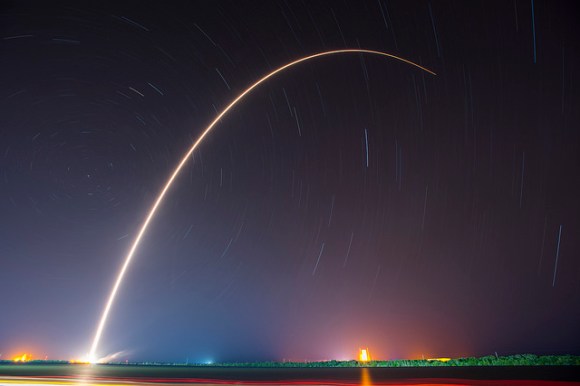
In addition to a second rocket landing at sea, SpaceX put a Japanese satellite in geosynchronous transfer orbit.
As you likely already know, SpaceX made news last night/early this morning when they successfully launched and landed a Falcon 9 rocket on a barge at sea. Their second successful recovery at sea and their third rocket landing overall, the landing elicited cheers from SpaceX employees and gleeful squeals of delight from people watching at home.
▼ And blew up Twitter with this photo.
Landing confirmed. Second stage continuing to carry JCSAT-14 to a Geosynchronous Transfer Orbit. pic.twitter.com/HfHI5cwoYX
— SpaceX (@SpaceX) May 6, 2016
Perhaps one of the biggest reason for the popularity of SpaceX is its openness to sharing copious amounts of dazzling videos and photos with the public. Sometimes it results in everyone getting to see one of their rockets explode as it tries to land, and other times it provides gorgeous images. After all, who could complain about something that looks this awesome?
▼ Feel free to make the “whooooosh” noises yourself.
But in all the excitement about the launch and landing of the Falcon 9 rocket, we started to wonder — just what was SpaceX putting into space?!
▼ Beside awesome photo opportunities.
The Falcon 9 second stage delivered JCSAT-14 to a Geosynchronous Transfer Orbit pic.twitter.com/GA5x9GMlgW
— SpaceX (@SpaceX) May 6, 2016
As it turns out, the satellite was JCSAT-14, a communications satellite owned by Tokyo-based telecommunications company SKY Perfect JSAT Corporation. The satellite is actually going to be replacing an older satellite and will be positioned in geosynchronous orbit so as to offer communications service to Japan and the Asia-Pacific region, including Russia and even Hawaii.
▼ But first, it rode off into the…sun?
The satellite weighed nearly 4,700 kilograms (about 10,360 pounds) at launch, a large part of which was fuel. Though SpaceX got the satellite to space, JCSAT-14 will “circularize” its orbit itself under its own power. Once testing is completed, the new satellite will begin operation and is expected to be in service for 15 years.
In case you missed the launch/landing/deployment live, you can watch it all with the YouTube clip below! It’s a bit long, though, so you may want to skip around a bit.
Fortunately, it looks like everyone was able to avoid the animated infighting we saw in the 2013 promotional video for NASA and JAXA’s DPR-equipped satellite. Though, if SpaceX is looking to hire some engineers from Japan, they should definitely consider taking a page from the JSDF recruitment book.
Sources: Twitter/SpaceX, SpaceX, SKY Perfect JSAT Corporation, SatBeams, NASA Space Flight, YouTube/SpaceX
Featured image: Flickr/SpaceX
Images: Twitter/SpaceX

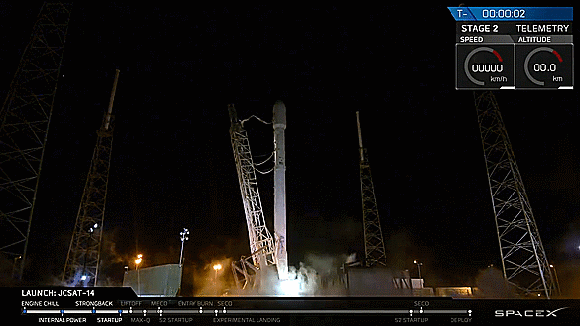
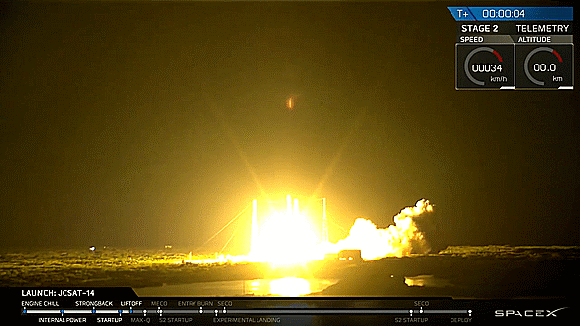
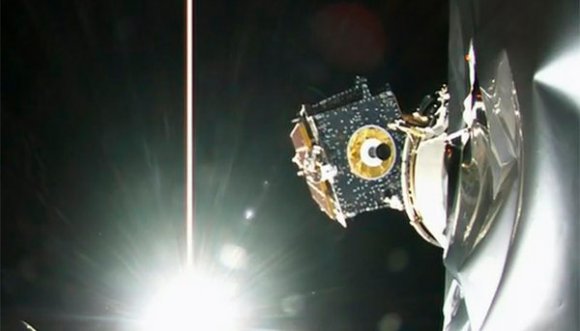
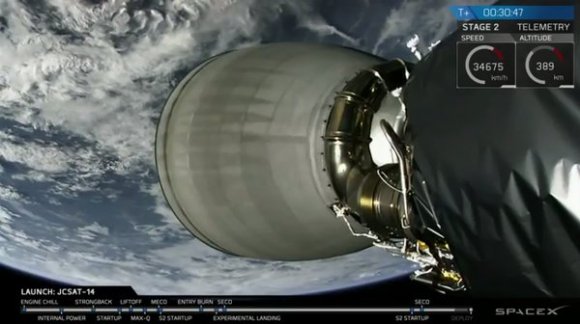
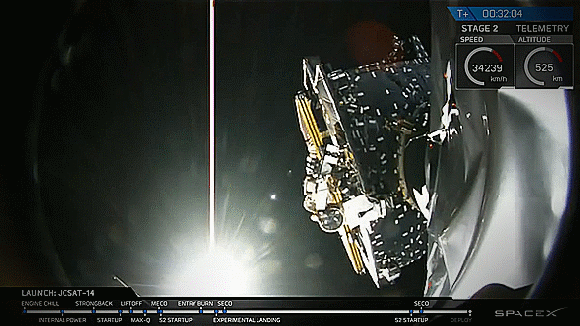
 Japan to release Gundam and Char’s Zaku into space to orbit Earth, ahead of Tokyo 2020 Olympics
Japan to release Gundam and Char’s Zaku into space to orbit Earth, ahead of Tokyo 2020 Olympics Japanese monks want to create new temple…in space!
Japanese monks want to create new temple…in space! Space One rocket explodes immediately after liftoff in Japan【Videos】
Space One rocket explodes immediately after liftoff in Japan【Videos】 Japan forced to call off first-ever unmanned Moon-landing attempt
Japan forced to call off first-ever unmanned Moon-landing attempt Ramen restaurant’s English menu prices are nearly double its Japanese ones, denies discriminating
Ramen restaurant’s English menu prices are nearly double its Japanese ones, denies discriminating Here’s what our bachelor writers ate over the New Year’s holiday in Japan
Here’s what our bachelor writers ate over the New Year’s holiday in Japan How to get a job in anime with Studio Ghibli director Hayao Miyazaki
How to get a job in anime with Studio Ghibli director Hayao Miyazaki Shiba Inu bring the cute and cuddly, leave us all wanting a snuggle
Shiba Inu bring the cute and cuddly, leave us all wanting a snuggle Dragon Quest Burgers and Slime drinks are coming to McDonald’s Japan【Video】
Dragon Quest Burgers and Slime drinks are coming to McDonald’s Japan【Video】 Japan chooses its top 3 night views【Photos】
Japan chooses its top 3 night views【Photos】 Mackerel chips coming to Japan…for gamers!
Mackerel chips coming to Japan…for gamers! That time our reporter’s classmate became possessed by a dead child at school
That time our reporter’s classmate became possessed by a dead child at school Young photographer and his gear steal the show at cosplay event, kind of looks like Doc Ock
Young photographer and his gear steal the show at cosplay event, kind of looks like Doc Ock What makes a good boss in Japan? Workers sound off in survey
What makes a good boss in Japan? Workers sound off in survey Japanese beef bowl chain Sukiya’s 2026 Smile Box lucky bag basically pays for itself
Japanese beef bowl chain Sukiya’s 2026 Smile Box lucky bag basically pays for itself Starbucks Japan ready to get Year of the Horse started with adorable drinkware and plushies【Pics】
Starbucks Japan ready to get Year of the Horse started with adorable drinkware and plushies【Pics】 Hayao Miyazaki says Happy New Year to Studio Ghibli fans with new art for Year of the Horse
Hayao Miyazaki says Happy New Year to Studio Ghibli fans with new art for Year of the Horse Cup Noodle tries an authentic Jiro-style ramen, but something’s not quite right
Cup Noodle tries an authentic Jiro-style ramen, but something’s not quite right Top Japanese cosplayer Enako returns to Comiket after 6 years, creates mayhem with admirers
Top Japanese cosplayer Enako returns to Comiket after 6 years, creates mayhem with admirers The best Starbucks Japan Frappuccinos we want to drink again in 2026
The best Starbucks Japan Frappuccinos we want to drink again in 2026 We revisited Sweets Paradise after a decade to see if Japan’s dessert buffet still delivers
We revisited Sweets Paradise after a decade to see if Japan’s dessert buffet still delivers That time Seiji called JASRAC to ask why he didn’t get paid royalties for his song being on TV
That time Seiji called JASRAC to ask why he didn’t get paid royalties for his song being on TV Pizza Hut Japan’s hot lucky bags are perfect for a New Year’s pizza party
Pizza Hut Japan’s hot lucky bags are perfect for a New Year’s pizza party Majority of Japanese mayors say foreign residents are essential but most see good and bad effects
Majority of Japanese mayors say foreign residents are essential but most see good and bad effects 7-Eleven Japan starts new temporary luggage storage service in over 300 branches
7-Eleven Japan starts new temporary luggage storage service in over 300 branches Disillusionment at Tsukiji’s tourist-target prices led us to a great ramen restaurant in Tokyo
Disillusionment at Tsukiji’s tourist-target prices led us to a great ramen restaurant in Tokyo Starbucks teams up with 166-year-old Kyoto doll maker for Year of the Horse decorations【Photos】
Starbucks teams up with 166-year-old Kyoto doll maker for Year of the Horse decorations【Photos】 Tokyo considering law requiring more trash cans following litter increase in heavily touristed area
Tokyo considering law requiring more trash cans following litter increase in heavily touristed area Tokyo’s Tsukiji sushi neighborhood asks tour groups to stay away for the rest of the month
Tokyo’s Tsukiji sushi neighborhood asks tour groups to stay away for the rest of the month Tokyo event lets you travel back in time, for free, to celebrate 100 years since Showa era start
Tokyo event lets you travel back in time, for free, to celebrate 100 years since Showa era start Japan may add Japanese language proficiency, lifestyle classes to permanent foreign resident requirements
Japan may add Japanese language proficiency, lifestyle classes to permanent foreign resident requirements Sanrio theme park in Japan announces plans to expand into a Sanrio resort
Sanrio theme park in Japan announces plans to expand into a Sanrio resort Lacquerware supplier to emperor of Japan and Pokémon team up for new tableware
Lacquerware supplier to emperor of Japan and Pokémon team up for new tableware Survey asks foreign tourists what bothered them in Japan, more than half gave same answer
Survey asks foreign tourists what bothered them in Japan, more than half gave same answer Japan’s human washing machines will go on sale to general public, demos to be held in Tokyo
Japan’s human washing machines will go on sale to general public, demos to be held in Tokyo Japan’s deadliest food claims more victims, but why do people keep eating it for New Year’s?
Japan’s deadliest food claims more victims, but why do people keep eating it for New Year’s? We deeply regret going into this tunnel on our walk in the mountains of Japan
We deeply regret going into this tunnel on our walk in the mountains of Japan Studio Ghibli releases Kodama forest spirits from Princess Mononoke to light up your home
Studio Ghibli releases Kodama forest spirits from Princess Mononoke to light up your home Major Japanese hotel chain says reservations via overseas booking sites may not be valid
Major Japanese hotel chain says reservations via overseas booking sites may not be valid Put sesame oil in your coffee? Japanese maker says it’s the best way to start your day【Taste test】
Put sesame oil in your coffee? Japanese maker says it’s the best way to start your day【Taste test】 No more using real katana for tourism activities, Japan’s National Police Agency says
No more using real katana for tourism activities, Japan’s National Police Agency says Starbucks Japan reveals new sakura drinkware collection, inspired by evening cherry blossoms
Starbucks Japan reveals new sakura drinkware collection, inspired by evening cherry blossoms Updated cherry blossom forecast shows extra-long sakura season for Japan this year
Updated cherry blossom forecast shows extra-long sakura season for Japan this year
Leave a Reply